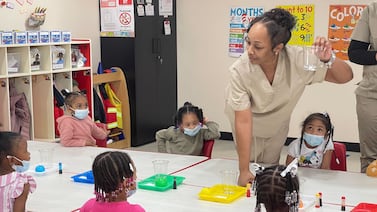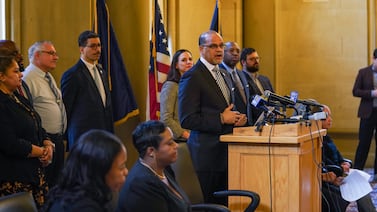Sign up for our free monthly newsletter Beyond High School to get the latest news about college and career paths for Colorado’s high school grads.
Most community college students say they want a four-year degree. But nearly nine out of 10 Colorado community college students don’t go on to earn a bachelor’s degree, new data shows.
Just 13% of Colorado community college students transfer and finish with a bachelor’s degree six years after starting college, the national measure used to track graduation rates. And the rate is even lower for older students, students of color, and those from low-income backgrounds.
The data is included in a study published earlier this month by the Community College Research Center at Teachers College, Columbia University, the Aspen Institute College Excellence Program, and National Student Clearinghouse Research Center. The study has been published regularly since 2017.
Colorado’s rate is lower than the 16% national figure, and places it in the bottom half of states when it comes to helping community college students obtain a bachelor’s degree, according to the report. Nonetheless, no state is doing a good job at serving these students, said Tania LaViolet, director of research and innovation at the Aspen Institute College Excellence Program.
“Not a single state supports more than a quarter of their community college students in completing a bachelor’s degree,” she said. “That’s unacceptable.”
The data is based on students who were first-time college goers during the 2015-16 academic year. (Colorado doesn’t track most of the information within the report.)
For the first time, researchers who worked on the latest version of the study were able to track what outcomes looked like by race, ethnicity, and income.
The data shows that about a third of all Colorado community college students transferred to a four-year public institution. Of that group, only 40% made it to graduation — even though almost three-quarters of all transfers stick with their four-year diploma track into their second year.
The state is even less effective at helping students of color, older students, and students from low-income backgrounds get a four-year degree. Of the state’s community college students, schools awarded a bachelor’s degree to:
Become a Chalkbeat sponsor
- 9% of Black students.
- 11% of Hispanic students.
- 7% of students who were 25 and older.
- 10% of students who are from low-income backgrounds.
Meanwhile, about 19% of all white students and 26% of all Asian American students who started at a community college went on to earn a bachelor’s degree.
The authors offer several strategies states could use to help these students, many of whom struggle with the high cost of college or barriers to finding reliable child care, housing, or transportation. The report says states can better track students, create more transfer options, boost dual enrollment opportunities, and do a better job helping students encountering life or academic challenges.
The report’s authors question how well schools support community college students who want to enroll in and graduate from a four-year university. Most states, including Colorado, don’t share very much information about transfer students.
“We’ve got to think about how we can support students both beforehand and then once they transfer to the four-year institution,” LaViolet said.
Colorado has some long-standing guaranteed transfer programs, which ensure credits transfer toward a four-year degree, and the number of agreements between community colleges and universities has increased in recent years.
The authors said dual enrollment opportunities help more students stay on track to getting a four-year degree. These programs allow high school students to take college classes and earn college credit before they graduate high school.
Colorado has offered dual enrollment opportunities for years, and lawmakers are looking at ways to better the state’s fragmented dual enrollment system for high school students and improve workforce training.
In total, 29% of Colorado’s community college students with dual enrollment experience end up eventually getting their bachelor’s degree six years later, more than double the overall rate statewide.
A little more than half of all students with dual enrollment experience end up transferring to a four-year university. And then about half of those students end up graduating.
LaViolet said the data shows dual enrollment does help, but shouldn’t be the only solution.
Become a Chalkbeat sponsor
“It’s evident in the data that they are not making it through to transfer as efficiently as we would like, and then to completion at the four-year institution as efficiently as we would like,” LaViolet said. “So there will be no silver bullet.”
Jason Gonzales is a reporter covering higher education and the Colorado legislature. Chalkbeat Colorado partners with Open Campus on higher education coverage. Contact Jason at jgonzales@chalkbeat.org.






